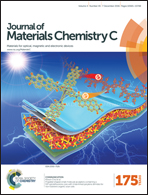Calix[4]resorcinarene-based branched macromolecules for all-optical photorefractive applications†
Abstract
By introducing nonlinear optical (NLO) chromophores to calix[4]resorcinarene, a non-centrosymmetric core, through powerful click chemistry reactions, two branched macromolecules (CRA-CzAZO and CRA-CzCSN) were obtained in satisfactory yields for photorefractive (PR) applications. In comparison with traditional PR materials, which usually need a high external electric field or a poling procedure to realize the PR effect, CRA-CzAZO and CRA-CzCSN can show a good all-optical PR (AOPR) effect, namely showing the PR effect without an external electric field, due to their special non-centrosymmetric topological structure. Two-beam coupling technology is used to prove the PR performance, and a high coupling gain coefficient of 83.2 cm−1 is realized with zero field through optically transparent films of CRA-CzAZO doped with 30% N-ethyl-carbazole as the plasticizer and photoconductor, and 1% C60 as the photosensitizer, indicating that a CRA-CzAZO based composite thin film could serve as a good candidate for real PR applications. More importantly, CRA-CzAZO and CRA-CzCSN provide a new simple design strategy for AOPR materials.
![Graphical abstract: Calix[4]resorcinarene-based branched macromolecules for all-optical photorefractive applications](/en/Image/Get?imageInfo.ImageType=GA&imageInfo.ImageIdentifier.ManuscriptID=C6TC04062D&imageInfo.ImageIdentifier.Year=2016)


 Please wait while we load your content...
Please wait while we load your content...